Atomic nucleus
1. What properties does the atomic nucleus have?
Solution:
The atomic nucleus forms the central part of the atom. It accounts for almost all of its mass. The atomic nucleus contains protons and neutrons—nucleons.
Atomic constant:
mu,Ar=1,m=1.6605⋅10−27kg=931.5MeV⋅c−2
Proton: p,Ar=1.0072,m=1.673⋅10−27kg=938.275MeV⋅c−2
Neutron: n,Ar=1.0086,m=1.673⋅10−27kg=939.565MeV⋅c−2
ZAX, Z= proton number (number of protons in the nucleus, electrons in the shell, the order of the element in the Mendeleev table)
N= neutron number (number of neutrons in the nucleus)
A= nucleon number A=N+Z (number of nucleons – protons and neutrons in the nucleus)
Isotopes are nuclides of the same element (same Z) that differ in neutron number N (and thus also in number A).
The mass of the nucleus mj is always smaller than the mass of Z protons and N neutrons.
Bj= mass defect of the nucleus:
mj<Z⋅mp+N⋅mn mj+Bj=Z⋅mp+N⋅mn Bj=(Z⋅mp+N⋅mn)−mj mj=Ar⋅mu
Binding energy of the nucleus:
Ej=Bjc2
Binding energy per nucleon:
εj=AEj
New unit of mass:
1MeV⋅c−2=1.7825⋅10−30kg 1kg=0.561⋅1030MeV⋅c−2
2.Lead has four isotopes. Determine the number of protons and neutrons in the nucleus.
Solution:
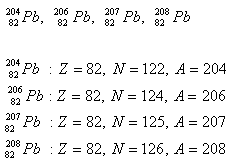
3. Calculate:
- a.) the rest mass of the nitrogen nucleus, given Ar(N) = 14,0067
- b.) the relative mass of the chlorine nucleus, given m(Cl) = 5,885·10–26 kg, 1 MeV·c–2 = 1,7825·10–30 kg, mu = 1,6605·10–27 kg
Solution:
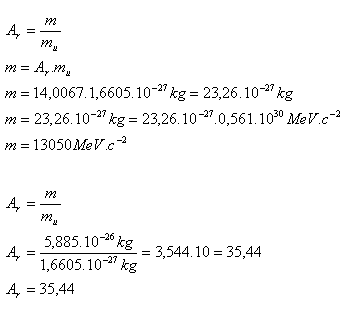
- The rest mass of the nitrogen nucleus is m = 13 050 MeV·c-2.
- The relative mass of the chlorine nucleus is Ar = 35.44.
4.Determine the mass defect, the binding energy, and the energy per nucleon for a radium nucleus. Express the energy in MeV.
Solution:
Analysis:
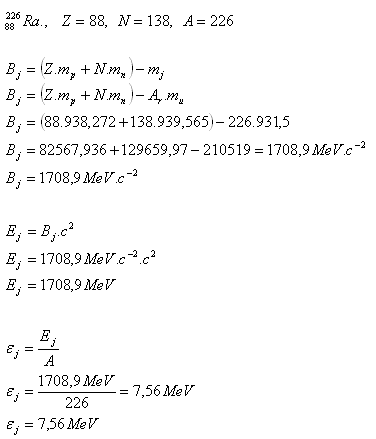
The mass defect is Bj = 1708.9 MeV·c-2, the binding energy is Ej = 1708.9 MeV, the energy per nucleon is εj = 7.56 MeV.
5.Determine the percent composition of chlorine with a relative atomic mass of 35.5, which is a mixture of isotopes
Solution:
Analysis:
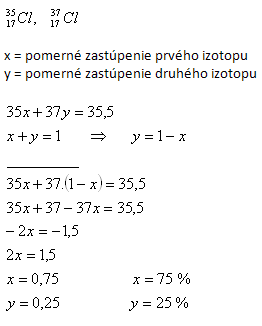
Chlorine contains 75% of the first isotope and 25% of the second isotope.
6.In the atomic bomb dropped by the Americans on Hiroshima, the charge contained 44.5 kg of uranium. What energy was released?
Solution:
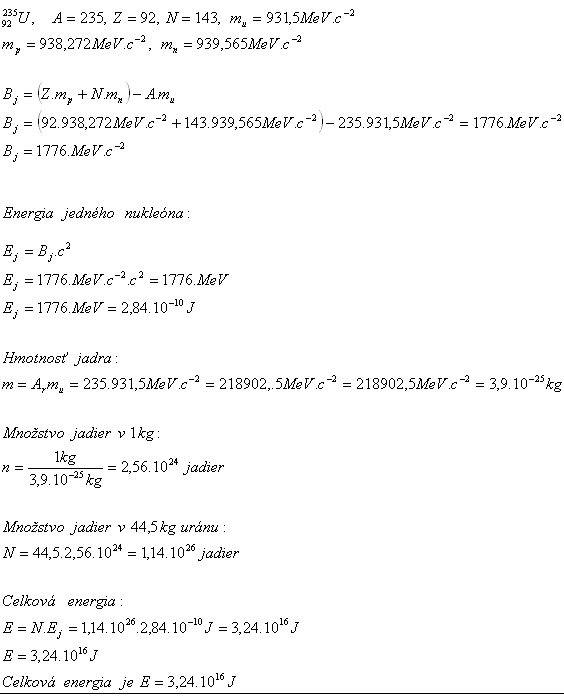
7.How long would it take a power plant, whose two blocks have a power output of P = 2,440 MW, to produce the energy from problem no. 6 (E = 3.24·1016 J)?
Solution:
Analysis:
E = 3.24·1016 J, P = 2,440 MW = 880·106 J·s-1, t = ?
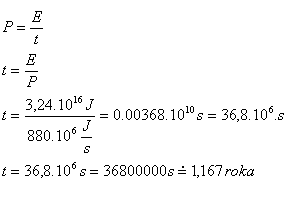
The power plant would produce this energy in 1.167 years.
8.A nucleus with mass number 100 and binding energy εj1 = 7.4 MeV splits into two nuclei with binding energy per nucleon εj2 = 8.2 MeV. What energy is released in the reaction?
Solution:
Analysis:
A = 100, εj1 = 7.4 MeV, εj2 = 8.2 MeV, Ej = ?
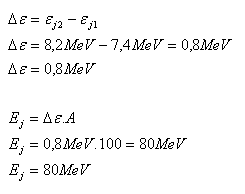
The reaction releases 80 MeV of energy.
9. Determine the energy obtainable by fission of 1 kg of uranium  if fission of one uranium nucleus releases 200 MeV of energy. What mass of hard coal with a heating value of 3·107 J·kg would be needed to obtain the same energy?
if fission of one uranium nucleus releases 200 MeV of energy. What mass of hard coal with a heating value of 3·107 J·kg would be needed to obtain the same energy?
Solution:
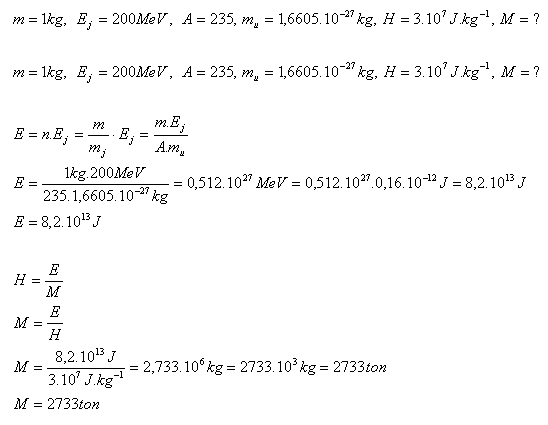
The mass of hard coal would need to be M = 2,733 tons.
10.A block of a nuclear power plant that converts nuclear energy into electrical energy with 40% efficiency has an electrical output of 600 MW. Determine the mass of uranium  consumed in 24 hours if fission of a single nucleus releases energy of 200 MeV.
consumed in 24 hours if fission of a single nucleus releases energy of 200 MeV.
Solution:
Analysis:
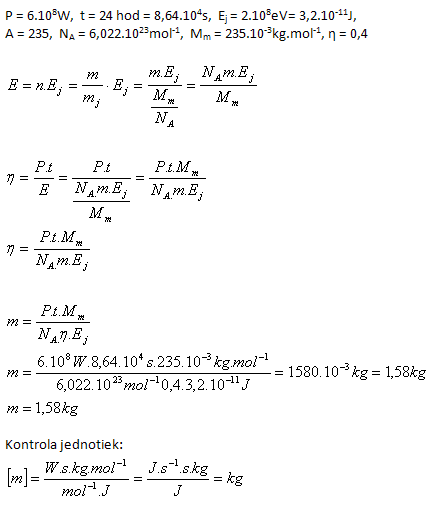
The mass of uranium is 1.58 kg.